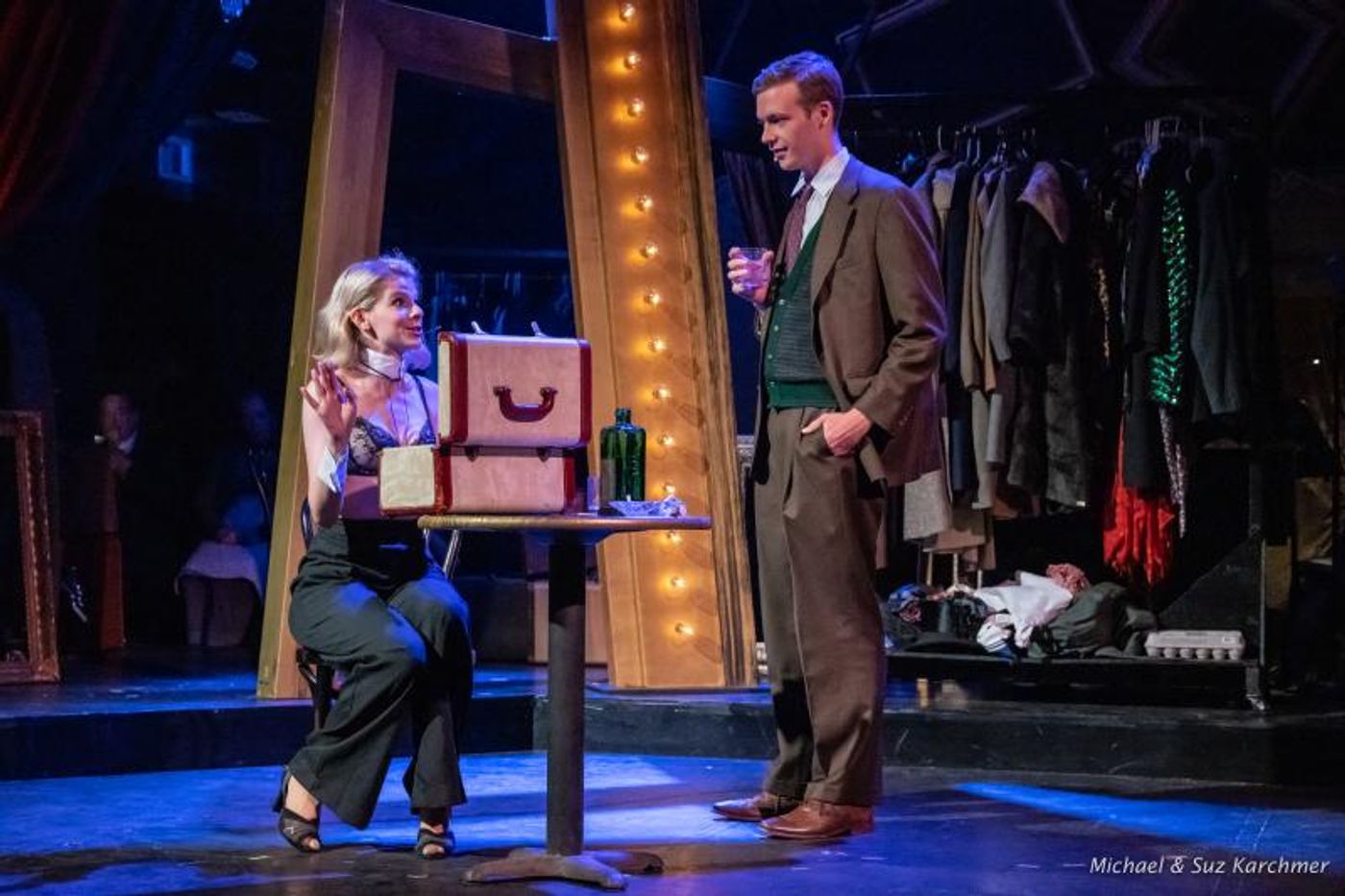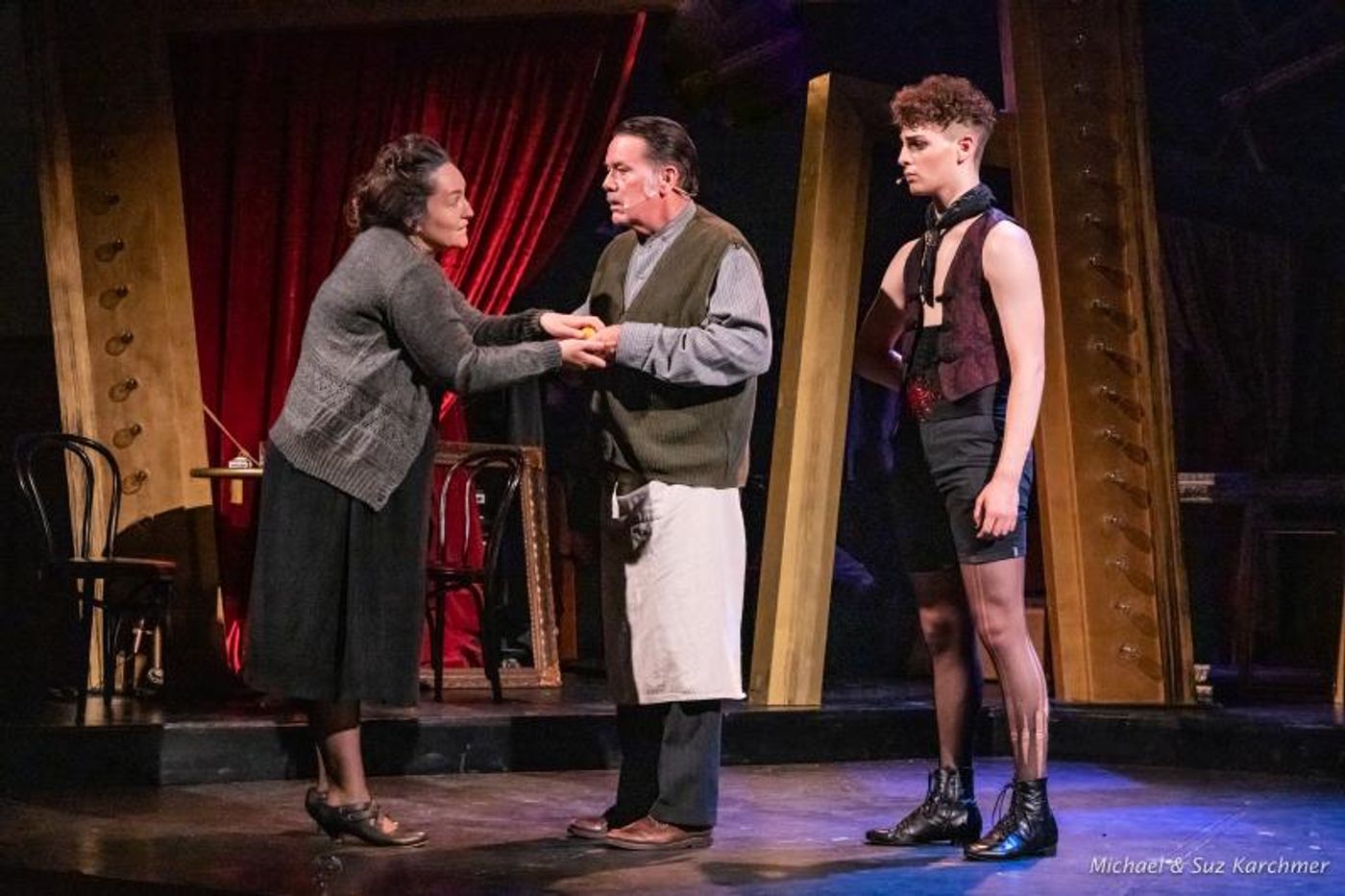Review: Peregrine Theatre Ensemble's CABARET Is Stunning

PROVINCETOWN - Director-choreographer Kyle Pleasant is back with Peregrine Theatre Ensemble's main stage summer show - and he has not come to play. Pleasant's CABARET gives you a hundred clues of what's to come. Yet this ending still hits you like a ton of ... well... bricks. And it reveals the window-smashing moment in Act 2 as a jump-scare curtain raiser on the descent into a violence and madness that left an August weekend audience speechless. They didn't recover until halfway through the curtain calls. Once again, Pleasant's thoughtful twists on a classic show both modernize its relevance and deepen its resolve.
"I told the cast repeatedly: The higher we bring the audience, the harder it will fall," he confesses.
Indeed, the first act is young and bright (this show does not feel any weight from Fosse's history with it - and Pleasant's group choreography is not to be missed). Peregrine's hallmark exquisite voices are here: Of particular note are Sarah Thorn (offering a defiant Sally Bowles, she's a college junior already showing signs of vocal greatness) and the accomplished Halcyone Joseph Kabral (Fräulein Schneider). Ryan McNevin's Emcee is more the Cumming/revival's sensual ringmaster than the Grey/original's dark manipulator. And the Schneider-Schulz love story at times steers toward rom-com - although later, Ian Leahy (Herr Schulz) will break your heart as the stalwart German nationalist who refuses to believe his countrymen are spiraling toward fascism.
Engaging Americans. To ensure an American audience's ascent, Pleasant opens the house with protagonist Cliff Bradshaw (heartfelt NYU Tisch junior Owen O'Leary) seated on stage. Dressed in travel clothes. Silent. Motionless (for 20 minutes). With pen and notebook in hand. It's a foreshadowing of the closing scene but no explanation is given. Meanwhile, ensemble members lurk upstage in the shadows of the labyrinth of this imposing cabaret, surreptitiously watching the audience.
"Sally, the Emcee, the cabaret girls - they tend to be the lens into this story," explains Pleasant. "But Cliff is our 'in' to the CABARET universe - every American is a foreigner in the cabaret, and Cliff's journey is too often forgotten. I wanted the audience to connect to Cliff from the beginning, by connecting to the end of his journey - with notebook and pencil. If the action were to start then, he would say: 'There was a cabaret and there was a master of ceremonies and there was a city called Berlin in a country called Germany...'"
But a motionless O'Leary is not the first thing one notices upon entering the house. Two enormous, empty picture frames dominate the stage, seemingly looming over the audience; at times, a more persistent character than the Emcee. They're attended by a receding group of progressively smaller empty frames that gorgeously move toward up-center stage. Set designer Ellen Rousseau's arrangement instantly conveys depth, with the downstage dominators cleverly serving as frames for specific locations in the story. To be sure, the downstage frames recede when the collection is lit up during the course of the story - within the context of Gifford Williams' provocative and nuanced lighting. But when the house lights are up, they're foreboding.

That's intentional, says Pleasant. He wants the audience to feel "on edge" and have the sense of being "encroached" upon from the beginning, to mirror the anxiety Weimar Republic Germans felt as the Nazis began to push into society. Also toward that end: Earnest accents (developed throughout rehearsals with a dialect coach) and entire conversations in German.
The third leg of this stool is the Ensemble itself. They never leave the stage - from house open through intermission and curtain call - although their number (dwindling) and nature (increasingly menacing) decidedly shift. Particularly in the way they watch the audience - by intermission, what was initially clandestine and from-the-shadows voyeurism is now brazen scrutiny. Judgmental. And from downstage.
"So much of the Nazis coming to power was whispering and then it turned into selling people out," Pleasant says. "So we wanted to flip the energy in the room [for the second act]. The actors aren't allowed to interact with audience members during intermission, but they can have eye contact. Their voyeurism from the first act turns into more of a warning: I'm watching you and you need to be aware of it."
That flip is a prelude to the changes coming in Act 2: "The Kit Kat Girls' kick line of the second act has the same essence as in the first act, but it turns into something grotesque," Pleasant adds. "And it's the first time we actually see political content put up in an artistic way in front of the audience."
Costume and color as harbingers. But it's costume designer Seth Bodie - in his third collaboration with Pleasant and Peregrine - who most masterfully charts this CABARET'S path.

and Ryan McNevin (The Emcee) in Peregrine Theatre Ensemble's CABARET.tion
"We talked a lot about what the degradation should look like in the clothing," says Pleasant. "How we would peel back slowly and take things away. By the time the [brutally beaten] Emcee gets to 'I Don't Care Much', he's in briefs and garter belts."
The next time we see the Emcee, he's dressed for a concentration camp.
"We start off with color in the same way," Pleasant continues. "The Weimar Republic was very colorful. We pull the plug halfway through the first act - first softening the color and palette -- and then we slowly drain it out. "
Indeed, the only color that gains in presence throughout the show is red. It becomes prominent first as wristbands on cabaret dancer and growing Nazi sympathizer Fräulein Kost (a commanding Caitlin Rose). Later it's a sequined belt adornment on the Emcee during a showcase number. And ultimately it's the Ensemble's final destination, in a stunning scene that also marks the show's best use of light and sound.
"Red was something we needed to be very careful of," Pleasant says. "Once it appears, it is like a scarlet letter on the most vulnerable. You don't see a Nazi armband until the end of Act 1."
Avoiding the vulgar. Pleasant's End of Show begins with Sally dropping her shoes wearily in Act 2 on her return from a clinic - her shoes don't move from the spot. "She's the first character to deposit herself into the moment," he explains.
It progresses during what feels like a slow-motion culmination of the three ambient markers of this CABARET'S journey - the color red, the Ensemble (in a new, very powerful moment), and ultimately the Emcee. Pleasant's decision to represent the essence of horrific events instead of being explicit, veering toward what he calls the "sometimes vulgar" depictions of other productions, only adds to the impact of the close. It's a fitting choice for a director who also decided to use the original lyrics of "If You Could See Her."
And those empty picture frames? "They're empty because of our inability to put images in them," says Pleasant. "They are the memories we lost and will never be able to create because they were taken away from us."
The Peregrine principle. CABARET caps a string of recent Peregrine triumphs, including Pleasant's Hair and Chicago, even as the company stages increasingly ambitious shows. In one sense, the poignant Tony- and Oscar-winning CABARET is a curious choice for a summer vacation crowd. But co-founders Adam Berry (executive producing director) and Ben Berry (artistic director) have conditioned Peregrine's audience to expect polished, provocative and memorable experiences. CABARET convincingly continues the trend.
CABARET. Through August 31st at Provincetown's Fishermen Hall. Nightly at 7:30pm. Tickets at cabaretptown.com or www.peregrinetheatre.com.
Reader Reviews
Videos

